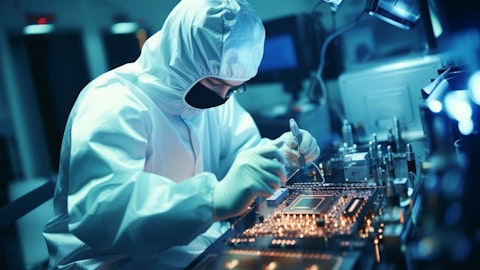And I think in the fiscal ’25 time frame, we have framed it as low tens of millions of lows in revenue within an expense substantially higher than that in fiscal 2016 and beyond. But that’s the way I would frame the portion of our business that’s not related to our top customer.
Christopher Rolland: Okay. Low tens of millions, I guess, would be just 10% and then layer these other opportunities on top. And if it’s tens of millions, 20 million, I mean that would be 20% — 10% plus growth. But I guess moving on, you talked about you guys taped out your next-gen CLC, just curious as to any new functionalities or ASP? And if not, maybe talk about your new power and battery products, even though the time table is further out.
John Forsyth: Thank you, Chris. Yes, I mentioned that we, in the past quarter did see silicon for our first — for a camera control IP on a new process, we’re excited about that. That’s kind of running ahead of our road map a little to get our arms around new process and new IP and new customer features. So what we see in that part of our product portfolio is a continued desire over time for increased processing capability. That translates into higher performance, stabilization focus and other features that are very meaningful to the end-user camera experience. So we have, I think, a pretty rich road map there, and we’ll continue to invest in it and continue to see, I think, over time, that kind of steady rate of growth that we’ve seen since the introduction of the first camera controller 4 years ago.
In the battery and power space, we’ve made a lot of progress over the past year on IP, both in design and seeing much of that in silicon. We’re actively engaged with customers in how that gets to market. Clearly, there are areas in the general market business where you can see some of our power IP being productized. For example, I mentioned the power converter product. It’s a part of the Lunar Lake reference design. But we really want to get that into the hands of as many of our customers and across as much of our business as possible. And we’re excited about that. As I’ve said previously, we’re very interested in stuff around the battery in particular, kind of building on what we’ve done to date around sensing and managing battery health. And so we don’t have more to report right now on what the product road map and timing looks like for that, but we’re excited that we’re making good progress in this space.
Operator: Your next question comes from the line of Tore Svanberg with Stifel.
Tore Svanberg: Yes. Thank you. And congratulations on the strong cash flows. I had a question for you first, John. So I’m not asking a question about your largest customer, anything like that. But with LLM starting to trickle down to edge devices like pieces and smart phones, I assume that the best interface is voice for AI at the edge. But I’m just wondering, just from an architectural perspective, if that is something that will — I mean are you starting to see some new designs with your IP to those types of use cases. I mean, I know there’s a lot of different angles here. I could be battery could be power. It could be voice audio. But yes, any color you could share with us as far as new design strength evolve on LMs trickling down to edge colitis?
John Forsyth: Yes. Absolutely, Tore. I think we see a multitude of positives and opportunities around the Gen AI space. And voice is certainly one of them. That’s one where across our customer base, we have multiple customers who are interested in how the voice interface evolves and assists the user interaction with generative AI. So that’s clearly one thing that we’re very interested in and looking at. But I think the opportunity set is really broader than that for us in the AI space. That’s a very important part of a part of the signal path that goes through our silicon, so we care a lot about voice. But there are other ways in which it can drive significant value for us. I think not only, of course, if it drives the — an upgrade cycle, in smartphones, watches, AR, VR and laptops.
I think we’re extremely well positioned to participate and benefit from that. I think secondly, it’s really clear that generative AI on the edge is — first of all, it’s going to be a thing, as you alluded to, because for privacy and latency reasons, I think that really has to be the case. That means there’s going to be a lot of data and processing going on, on the client device. And that means that we are going to see more memory needed and more and bigger processes and probably more in bigger batteries as well. And so that does a couple of things. One is it puts tremendous constraints on board space — and that — our advanced geometry mixed-signal space engineering really kind of plays squarely into that. We habitually are delivering very, very complex solutions in the mixed-signal space and integrating other components from around the board.
So I think the premium on board space is probably going to increase in these client devices and along with that, the premium on power efficiency as well. And again, that’s kind of squarely in the bull’s eye of a lot of our R&D investments and efforts. So I think of all of those things together as being potential levers for us in the opportunity set around AI.
Tore Svanberg: Yes. No, that’s great. And as my follow-up, so obviously, you’ve got the smart codec and the amplifiers ramping, I assume that obviously means some higher content. But at least, of course, initially, but as — I think you said in the shareholder letter, those to remain workhorse products for a while. How should we think about sort of ASP declines every year once those products have been introduced to the market? Should we think about sort of like low to mid-single-digit decline?
John Forsyth -: I think it’s difficult to say precisely, Tore, though I do think we’re entering a more normal, more typical kind of pricing environment than we’ve seen over the past few years. So I think a reasonable assumption. And certainly, we expect this of our suppliers. So I have no reason to think that our customers don’t expect it of us is that we see reasons for efficiency to increase for prices to come down somewhat in the coming years. But at the same time, our goal will always be to offset that through our own operational efficiency, but also through feature enhancements and integration of other functions into the devices we’re delivering to our end customers. But I think we’re probably moving back into an environment where there is something approaching a more typical pricing curve.
Operator: [Operator Instructions] And your next question comes from the line of Thomas O’Malley with Barclays.


